width HYUNDAI I20 2022 Owners Manual
[x] Cancel search | Manufacturer: HYUNDAI, Model Year: 2022, Model line: I20, Model: HYUNDAI I20 2022Pages: 444, PDF Size: 8.93 MB
Page 26 of 444
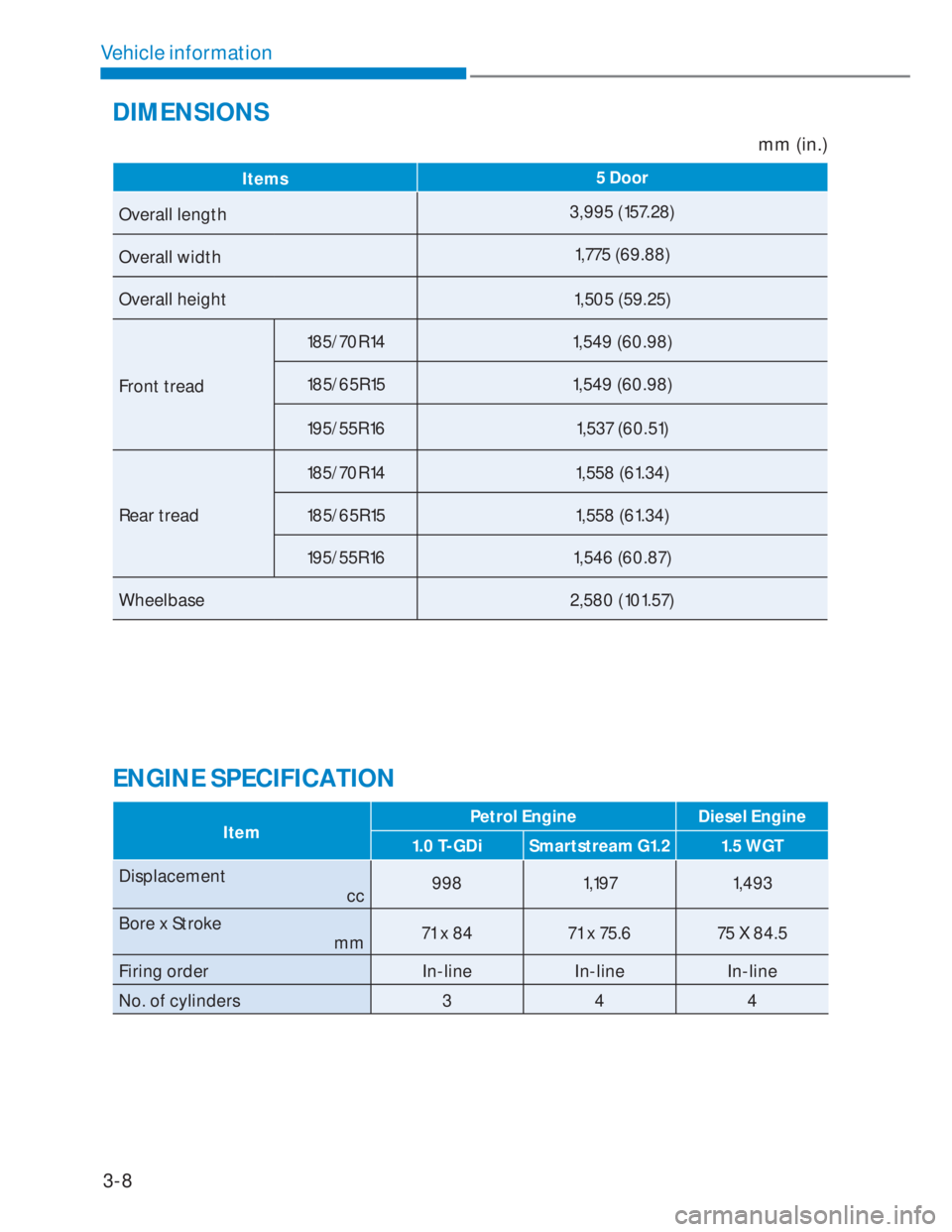
3-8
Vehicle information
DIMENSIONS
ENGINE SPECIFICATION
ItemPetrol Engine Diesel Engine
1.0 T-GDi Smartstream G1.2 1.5 WGT
Displacement
cc998 1,197 1,493
Bore x Stroke
mm71 x 84 71 x 75.6 75 X 84.5
Firing order In-line In-line In-line
No. of cylinders 3 4 4
Items5 Door
Overall length3,995 (157.28)
Overall width1,775 (69.88)
Overall height 1,505 (59.25)
Front tread185/70R14 1,549 (60.98)
185/65R15 1,549 (60.98)
195/55R16 1,537 (60.51)
Rear tread 185/70R14 1,558 (61.34)
185/65R15 1,558 (61.34)
195/55R16 1,546 (60.87)
Wheelbase 2,580 (101.57)
mm (in.)
Page 62 of 444
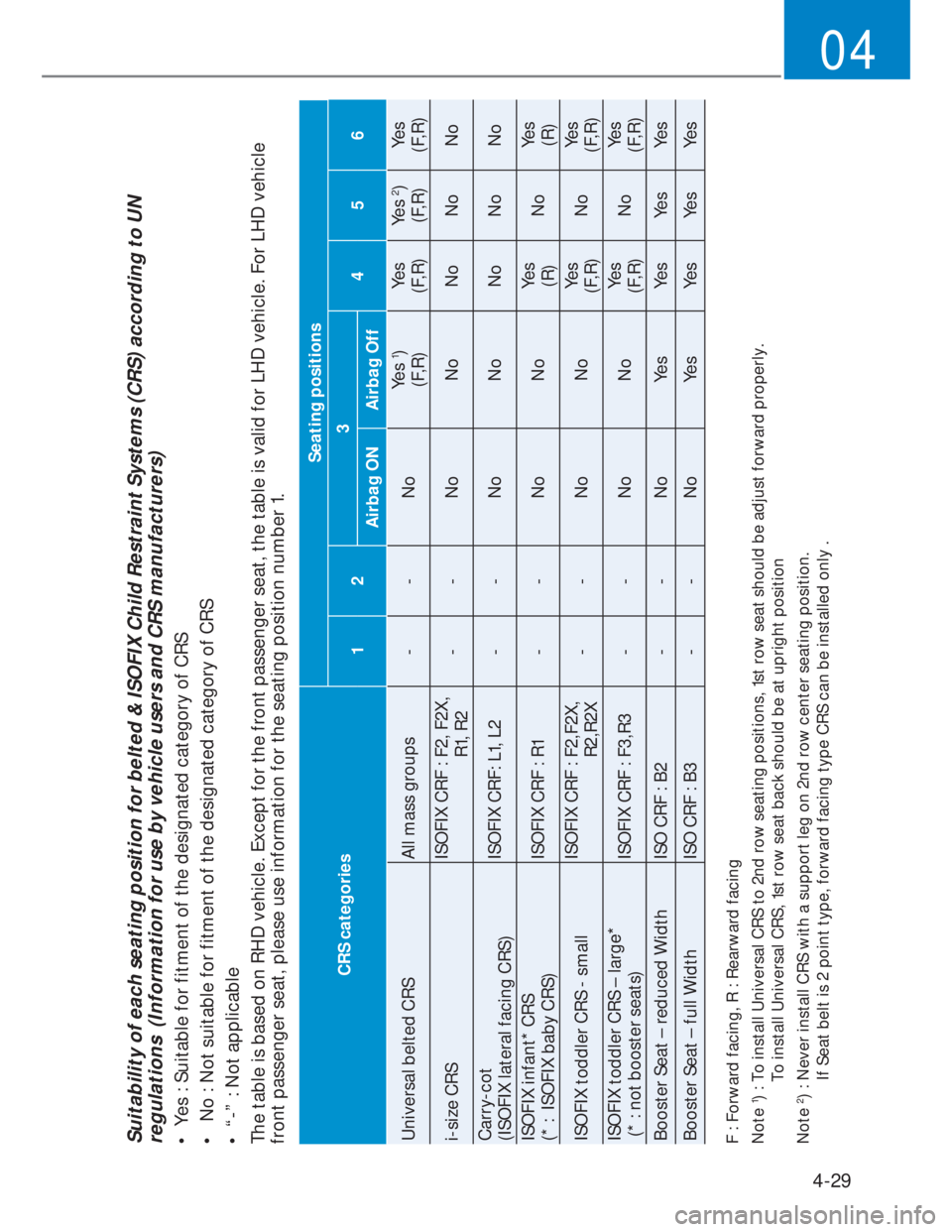
4-29
04
CRS categoriesSeating positions
123
456
Airbag ON Airbag Off
Universal belted CRS All mass groups - - NoYes
1)
(F,R)Yes
(F,R)Yes
2)
(F,R)Yes
(F,R)
i-size CRSISOFIX CRF : F2, F2X,
R1, R2- - No No No No No
Carry-cot
(ISOFIX lateral facing CRS)ISOFIX CRF: L1, L2 - - No No No No No
ISOFIX infant* CRS
(* : ISOFIX baby CRS)ISOFIX CRF : R1 - - No NoYes
(R)NoYes
(R)
ISOFIX toddler CRS - smallISOFIX CRF : F2,F2X,
R2,R2X- - No NoYes
(F,R)NoYes
(F,R)
ISOFIX toddler CRS – large*
(* : not booster seats)ISOFIX CRF : F3,R3 - - No NoYes
(F,R)NoYes
(F,R)
Booster Seat – reduced Width ISO CRF : B2 - - No Yes Yes Yes Yes
Booster Seat – full Width ISO CRF : B3 - - No Yes Yes Yes Yes
Suitability of each seating position for belted & ISOFIX Child Restraint Systems (CRS) according to UN
regulations (Information for use by vehicle users and CRS manufacturers)• Yes : Suitable for fitment of the designated category of CRS
• No : Not suitable for fitment of the designated category of CRS
• “-” : Not applicable
The table is based on RHD vehicle. Except for the front passenger seat, the table is valid for LHD vehicle. For LHD vehicle
front passenger seat, please use information for the seating position number 1.F : Forward facing, R : Rearward facing
Note
1) : To install Universal CRS to 2nd row seating positions, 1st row seat should be adjust forward properly.
To install Universal CRS, 1st row seat back should be at upright position
Note 2) : Never install CRS with a support leg on 2nd row center seating position.
If Seat belt is 2 point type, forward facing type CRS can be installed only .
Page 396 of 444
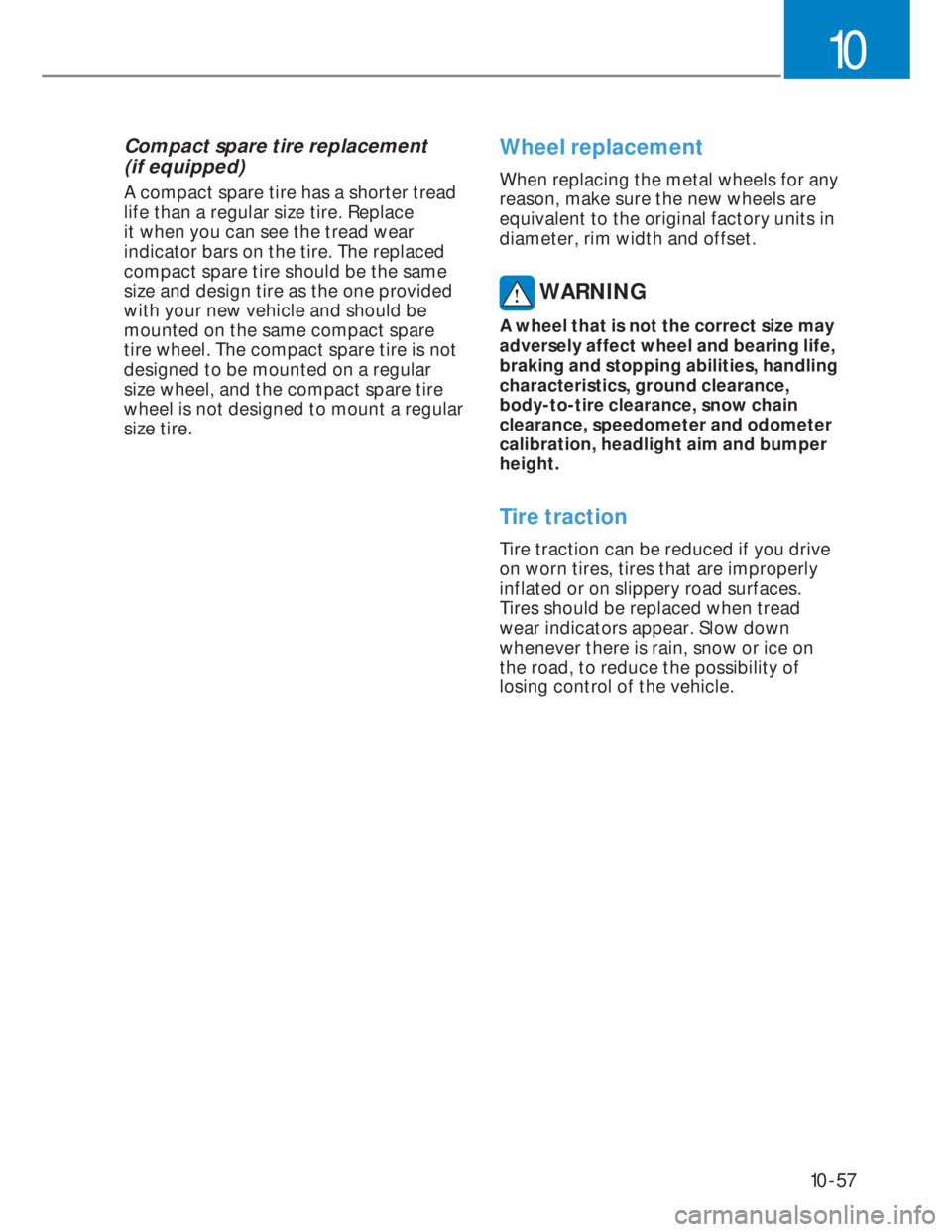
10-57
10
Compact spare tire replacement
(if equipped)
A compact spare tire has a shorter tread
life than a regular size tire. Replace
it when you can see the tread wear
indicator bars on the tire. The replaced
compact spare tire should be the same
size and design tire as the one provided
with your new vehicle and should be
mounted on the same compact spare
tire wheel. The compact spare tire is not
designed to be mounted on a regular
size wheel, and the compact spare tire
wheel is not designed to mount a regular
size tire.
Wheel replacement
When replacing the metal wheels for any
reason, make sure the new wheels are
equivalent to the original factory units in
diameter, rim width and offset.
WARNING
A wheel that is not the correct size may
adversely affect wheel and bearing life,
braking and stopping abilities, handling
characteristics, ground clearance,
body-to-tire clearance, snow chain
clearance, speedometer and odometer
calibration, headlight aim and bumper
height.
Tire traction
Tire traction can be reduced if you drive
on worn tires, tires that are improperly
inflated or on slippery road surfaces.
Tires should be replaced when tread
wear indicators appear. Slow down
whenever there is rain, snow or ice on
the road, to reduce the possibility of
losing control of the vehicle.
Page 397 of 444
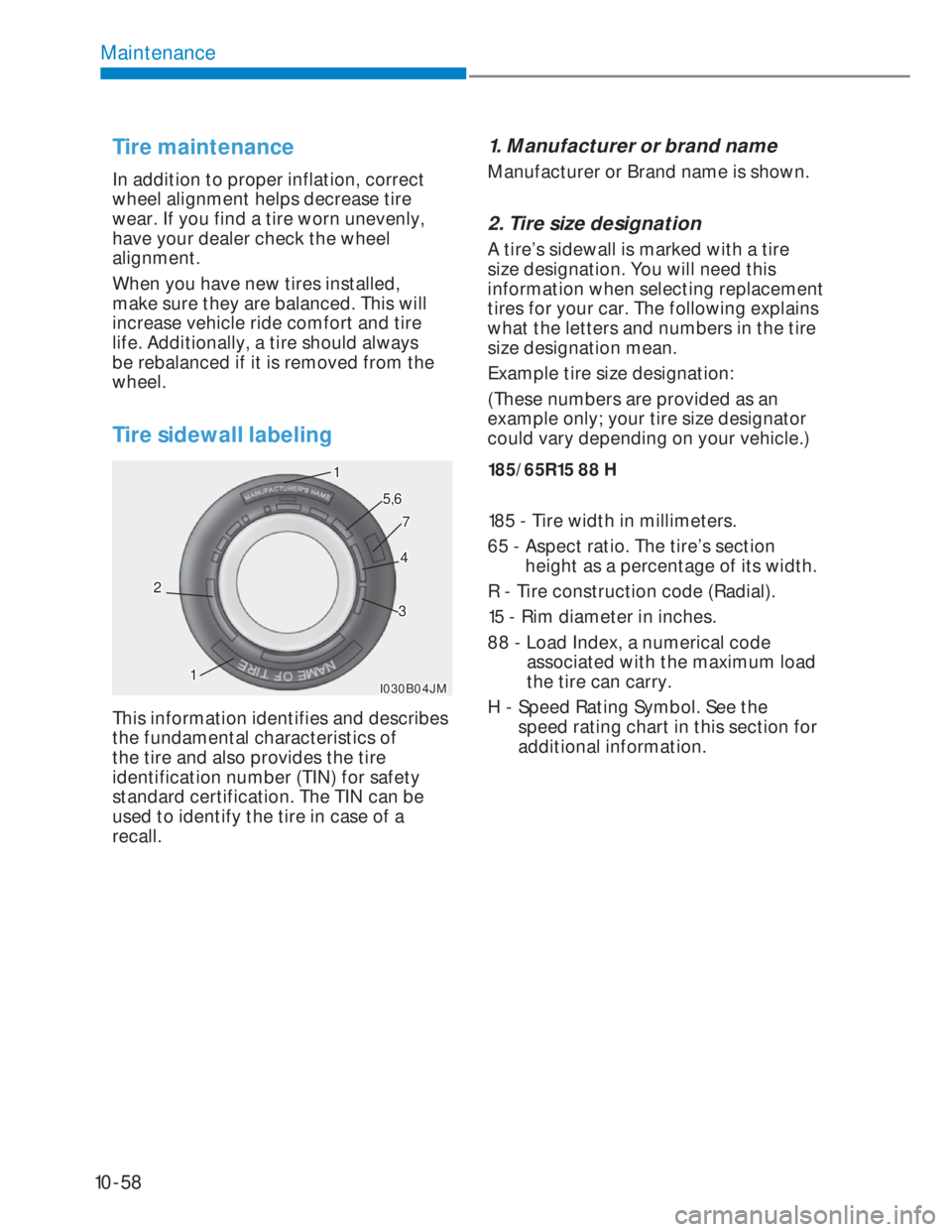
10-58
Maintenance
Tire maintenance
In addition to proper inflation, correct
wheel alignment helps decrease tire
wear. If you find a tire worn unevenly,
have your dealer check the wheel
alignment.
When you have new tires installed,
make sure they are balanced. This will
increase vehicle ride comfort and tire
life. Additionally, a tire should always
be rebalanced if it is removed from the
wheel.
Tire sidewall labeling
I030B04JMI030B04JM
22
11
77
5,65,6
33
44
11
This information identifies and describes
the fundamental characteristics of
the tire and also provides the tire
identification number (TIN) for safety
standard certification. The TIN can be
used to identify the tire in case of a
recall.
1. Manufacturer or brand name
Manufacturer or Brand name is shown.
2. Tire size designation
A tire’s sidewall is marked with a tire
size designation. You will need this
information when selecting replacement
tires for your car. The following explains
what the letters and numbers in the tire
size designation mean.
Example tire size designation:
(These numbers are provided as an
example only; your tire size designator
could vary depending on your vehicle.)
185/65R15 88 H
185 - Tire width in millimeters.
65 - Aspect ratio. The tire’s section
height as a percentage of its width.
R - Tire construction code (Radial).
15 - Rim diameter in inches.
88 - Load Index, a numerical code
associated with the maximum load
the tire can carry.
H - Speed Rating Symbol. See the
speed rating chart in this section for
additional information.
Page 398 of 444
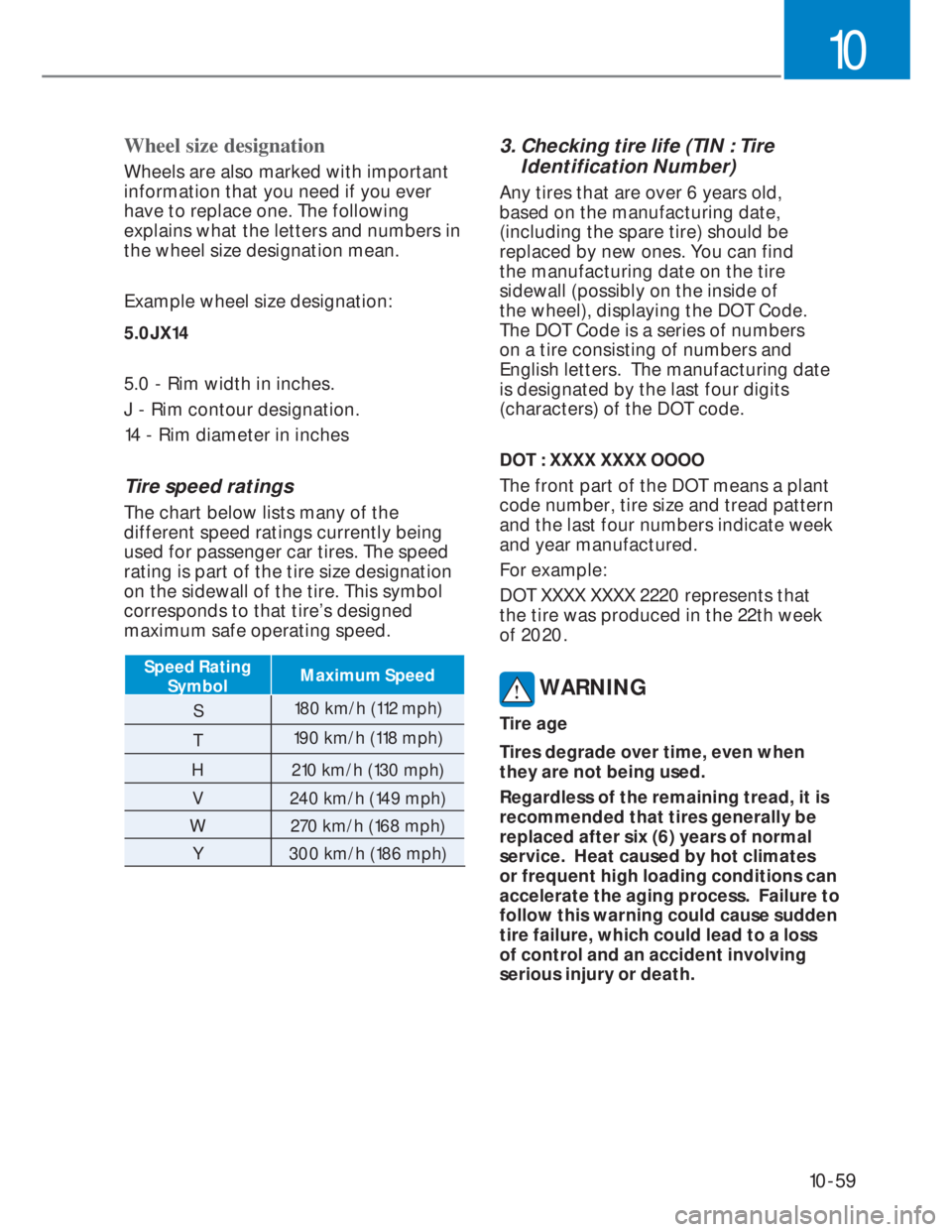
10-59
10
Wheel size designation
Wheels are also marked with important
information that you need if you ever
have to replace one. The following
explains what the letters and numbers in
the wheel size designation mean.
Example wheel size designation:
5.0JX14
5.0 - Rim width in inches.
J - Rim contour designation.
14 - Rim diameter in inches
Tire speed ratings
The chart below lists many of the
different speed ratings currently being
used for passenger car tires. The speed
rating is part of the tire size designation
on the sidewall of the tire. This symbol
corresponds to that tire’s designed
maximum safe operating speed.
Speed Rating
SymbolMaximum Speed
S180 km/h (112 mph)
T190 km/h (118 mph)
H 210 km/h (130 mph)
V 240 km/h (149 mph)
W 270 km/h (168 mph)
Y 300 km/h (186 mph)
3. Checking tire life (TIN : Tire
Identification Number)
Any tires that are over 6 years old,
based on the manufacturing date,
(including the spare tire) should be
replaced by new ones. You can find
the manufacturing date on the tire
sidewall (possibly on the inside of
the wheel), displaying the DOT Code.
The DOT Code is a series of numbers
on a tire consisting of numbers and
English letters. The manufacturing date
is designated by the last four digits
(characters) of the DOT code.
DOT : XXXX XXXX OOOO
The front part of the DOT means a plant
code number, tire size and tread pattern
and the last four numbers indicate week
and year manufactured.
For example:
DOT XXXX XXXX 2220 represents that
the tire was produced in the 22th week
of 2020.
WARNING
Tire age
Tires degrade over time, even when
they are not being used.
Regardless of the remaining tread, it is
recommended that tires generally be
replaced after six (6) years of normal
service. Heat caused by hot climates
or frequent high loading conditions can
accelerate the aging process. Failure to
follow this warning could cause sudden
tire failure, which could lead to a loss
of control and an accident involving
serious injury or death.
Page 399 of 444

10-60
Maintenance
4. Tire ply composition and material
The number of layers or plies of
rubber-coated fabric in the tire. Tire
manufacturers also must indicate the
materials in the tire, which include steel,
nylon, polyester, and others. The letter
“R” means radial ply construction; the
letter “D” means diagonal or bias ply
construction; and the letter “B” means
belted-bias ply construction.
5. Maximum permissible inflation
pressure
This number is the greatest amount
of air pressure that should be put in
the tire. Do not exceed the maximum
permissible inflation pressure. Refer to
the Tire and Loading Information label
for recommended inflation pressure.
6. Maximum load rating
This number indicates the maximum
load in kilograms and pounds that can
be carried by the tire. When replacing
the tires on the vehicle, always use a
tire that has the same load rating as the
factory installed tire.
7. Uniform tire quality grading
Quality grades can be found where
applicable on the tire sidewall between
tread shoulder and maximum chapter
width.
For example:
TREAD wear 200
TRACTION AA
TEMPERATURE A
Tread wear
The tread wear grade is a comparative
rating based on the wear rate of the tire
when tested under controlled conditions
on a specified government test course.
For example, a tire graded 150 would
wear one-and-a-half times (1½) as well
on the government course as a tire
graded 100.
The relative performance of tires
depends upon the actual conditions
of their use, however, and may depart
significantly from the norm due to
variations in driving habits, service
practices and differences in road
characteristics and climate.
These grades are molded on the side-
walls of passenger vehicle tires. The
tires available as standard or optional
equipment on your vehicle may vary
with respect to grade.